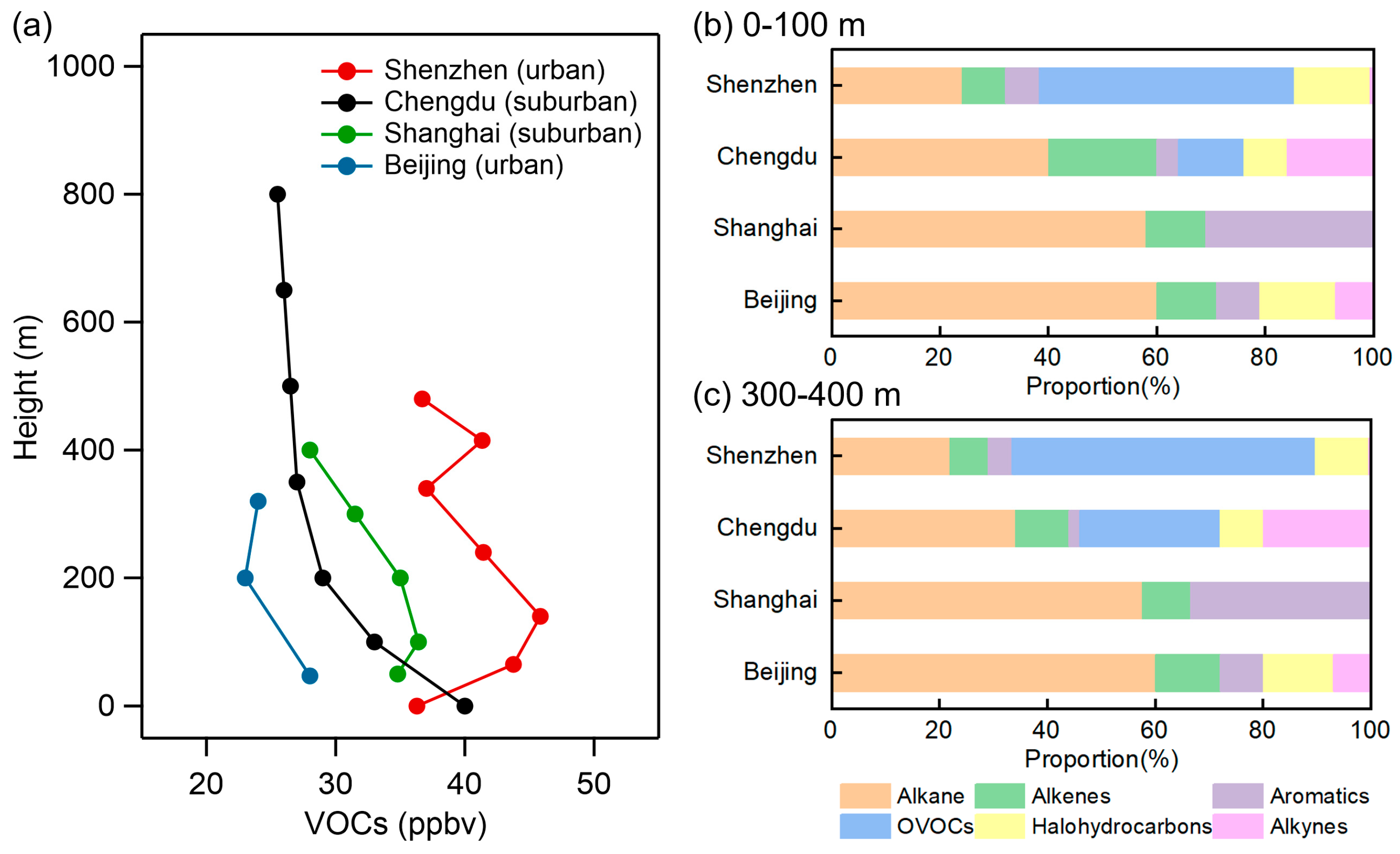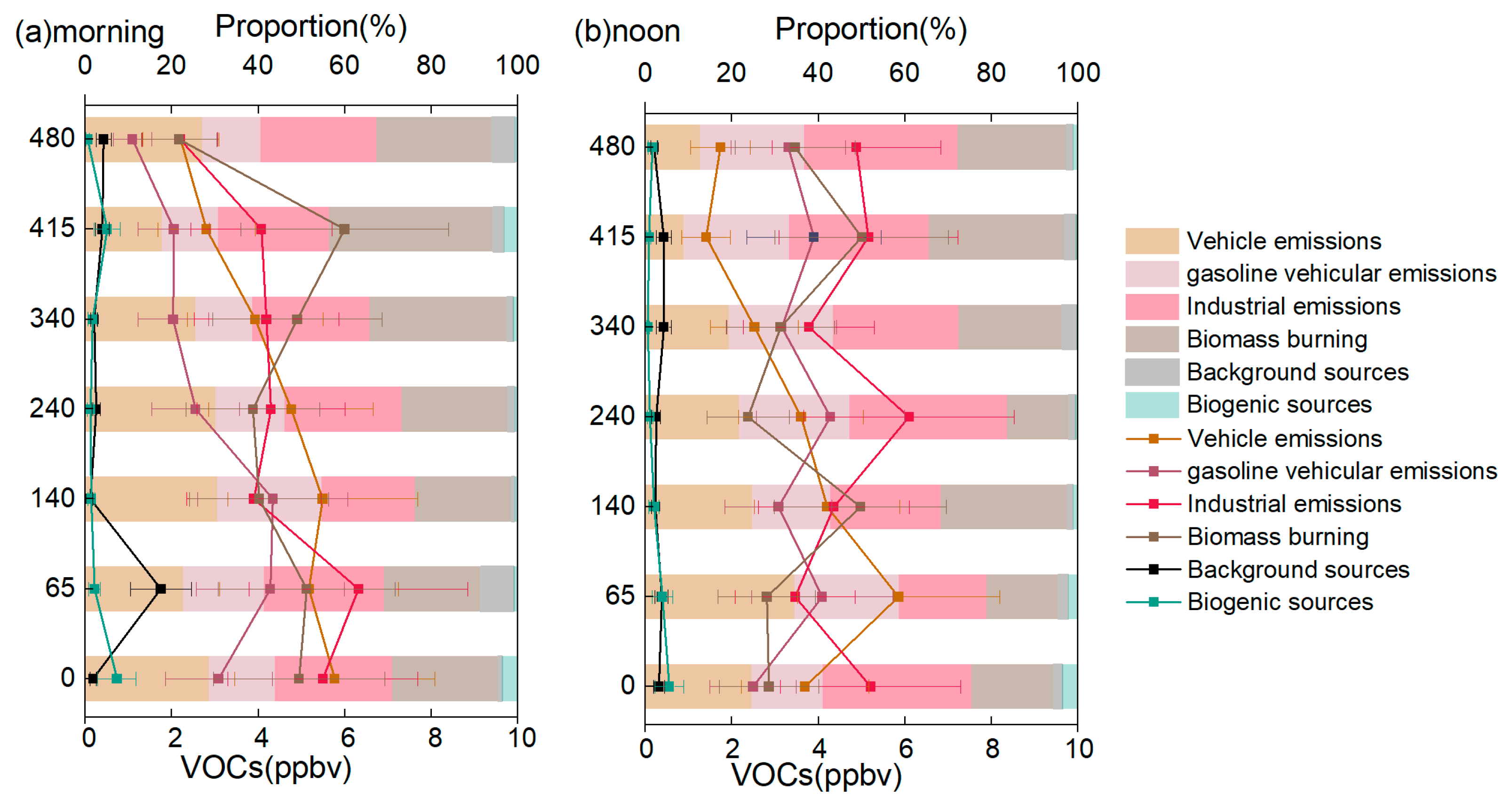Vertical Evolution of Volatile Organic Compounds from Unmanned Aerial Vehicle Measurements in the Pearl River Delta, China
Abstract
1. Introduction
2. Methods
2.1. Sampling Time, Location, and Strategy
2.2. UAV-Based Vertical Measurements of VOCs and Sample Analysis
2.3. Source Apportionment of VOCs
3. Results and Discussion
3.1. Vertical Characteristics of VOCs and OFP
3.2. Vertical Variation of the VOC Source Contributions
3.3. Vertical Evolution of Secondary Formation of OVOCs
4. Conclusions
Supplementary Materials
Author Contributions
Funding
Institutional Review Board Statement
Informed Consent Statement
Data Availability Statement
Conflicts of Interest
References
- Cao, T.; Wang, H.; Li, L.; Lu, X.; Liu, Y.; Fan, S. Fast spreading of surface ozone in both temporal and spatial scale in Pearl River Delta. J. Environ. Sci. 2024, 137, 540–552. [Google Scholar] [CrossRef] [PubMed]
- Liu, B.; Liang, D.; Yang, J.; Dai, Q.; Bi, X.; Feng, Y.; Yuan, J.; Xiao, Z.; Zhang, Y.; Xu, H. Characterization and source apportionment of volatile organic compounds based on 1-year of observational data in Tianjin, China. Environ. Pollut. 2016, 218, 757–769. [Google Scholar] [CrossRef] [PubMed]
- Li, B.; Ho, S.S.H.; Li, X.; Guo, L.; Feng, R.; Fang, X. Pioneering observation of atmospheric volatile organic compounds in Hangzhou in eastern China and implications for upcoming 2022 Asian Games. J. Environ. Sci. 2023, 124, 723–734. [Google Scholar] [CrossRef] [PubMed]
- Mo, Z.; Shao, M.; Lu, S.; Niu, H.; Zhou, M.; Sun, J. Characterization of non-methane hydrocarbons and their sources in an industrialized coastal city, Yangtze River Delta, China. Sci. Total Environ. 2017, 593–594, 641–653. [Google Scholar] [CrossRef]
- Li, Q.; Zhang, H.; Cai, X.; Song, Y.; Zhu, T. The impacts of the atmospheric boundary layer on regional haze in North China. npj Clim. Atmos. Sci. 2021, 4, 9. [Google Scholar] [CrossRef]
- Guo, H.; Ling, Z.H.; Cheng, H.R.; Simpson, I.J.; Lyu, X.P.; Wang, X.M.; Shao, M.; Lu, H.X.; Ayoko, G.; Zhang, Y.L.; et al. Tropospheric volatile organic compounds in China. Sci. Total Environ. 2017, 574, 1021–1043. [Google Scholar] [CrossRef]
- Wu, S.; Tang, G.; Wang, Y.; Yang, Y.; Yao, D.; Zhao, W.; Gao, W.; Sun, J.; Wang, Y. Vertically decreased VOC concentration and reactivity in the planetary boundary layer in winter over the North China Plain. Atmos. Res. 2020, 240, 104930. [Google Scholar] [CrossRef]
- Mo, Z.; Huang, S.; Yuan, B.; Pei, C.; Song, Q.; Qi, J.; Wang, M.; Wang, B.; Wang, C.; Shao, M. Tower-based measurements of NMHCs and OVOCs in the Pearl River Delta: Vertical distribution, source analysis and chemical reactivity. Environ. Pollut. 2022, 292, 118454. [Google Scholar] [CrossRef]
- Zhang, H.; Zhang, Y.; Huang, Z.; Acton, W.J.F.; Wang, Z.; Nemitz, E.; Langford, B.; Mullinger, N.; Davison, B.; Shi, Z.; et al. Vertical profiles of biogenic volatile organic compounds as observed online at a tower in Beijing. J. Environ. Sci. 2020, 95, 33–42. [Google Scholar] [CrossRef]
- Li, X.B.; Yuan, B.; Wang, S.; Wang, C.; Lan, J.; Liu, Z.; Song, Y.; He, X.; Huangfu, Y.; Pei, C.; et al. Variations and sources of volatile organic compounds (VOCs) in urban region: Insights from measurements on a tall tower. Atmos. Chem. Phys. 2022, 22, 10567–10587. [Google Scholar] [CrossRef]
- Vierling, L.A.; Fersdahl, M.; Chen, X.; Li, Z.; Zimmerman, P. The Short Wave Aerostat-Mounted Imager (SWAMI): A novel platform for acquiring remotely sensed data from a tethered balloon. Remote Sens. Environ. 2006, 103, 255–264. [Google Scholar] [CrossRef]
- Geng, C.; Wang, J.; Yin, B.; Zhao, R.; Li, P.; Yang, W.; Xiao, Z.; Li, S.; Li, K.; Bai, Z. Vertical distribution of volatile organic compounds conducted by tethered balloon in the Beijing-Tianjin-Hebei region of China. J. Environ. Sci. 2020, 95, 121–129. [Google Scholar] [CrossRef]
- Díez-Palet, I.; Jaén, C.; Marco, E.; Van Drooge, B.L.; Fernández, P.; Grimalt, J.O. Measurement of volatile organic compounds using tethered balloons in a polluted industrial site in Catalonia (Spain). Environ. Sci. Pollut. Res. 2024. [Google Scholar] [CrossRef] [PubMed]
- Xue, L.; Wang, T.; Simpson, I.J.; Ding, A.; Gao, J.; Blake, D.R.; Wang, X.; Wang, W.; Lei, H.; Jin, D. Vertical distributions of non-methane hydrocarbons and halocarbons in the lower troposphere over northeast China. Atmos. Environ. 2011, 45, 6501–6509. [Google Scholar] [CrossRef]
- Baker, A.K.; Schuck, T.J.; Slemr, F.; van Velthoven, P.; Zahn, A.; Brenninkmeijer, C.A.M. Characterization of non-methane hydrocarbons in Asian summer monsoon outflow observed by the CARIBIC aircraft. Atmos. Chem. Phys. 2011, 11, 503–518. [Google Scholar] [CrossRef]
- Flocas, H.A.; Assimakopoulos, V.D.; Helmis, C.G.; Güsten, H. VOC and O3 Distributions over the Densely Populated Area of Greater Athens, Greece. J. Appl. Meteorol. 2003, 42, 1799–1810. [Google Scholar] [CrossRef]
- Li, Y.; Liu, B.; Ye, J.; Jia, T.; Khuzestani, R.B.; Sun, J.Y.; Cheng, X.; Zheng, Y.; Li, X.; Wu, C.; et al. Unmanned Aerial Vehicle Measurements of Volatile Organic Compounds over a Subtropical Forest in China and Implications for Emission Heterogeneity. ACS Earth Space Chem. 2021, 5, 247–256. [Google Scholar] [CrossRef]
- Liu, Y.; Wang, H.; Jing, S.; Zhou, M.; Lou, S.; Qu, K.; Qiu, W.; Wang, Q.; Li, S.; Gao, Y.; et al. Vertical Profiles of Volatile Organic Compounds in Suburban Shanghai. Adv. Atmos. Sci. 2021, 38, 1177–1187. [Google Scholar] [CrossRef]
- Li, X.; Wang, W.; Yang, S.; Cheng, Y.; Zeng, L.; Yu, X.; Lu, S.; Liu, Y.; Hu, M.; Xie, S.; et al. Ozone sensitivity regimes vary at different heights in the planetary boundary layer. Sci. Total Environ. 2024, 944, 173712. [Google Scholar] [CrossRef]
- Pang, X.; Chen, L.; Shi, K.; Wu, F.; Chen, J.; Fang, S.; Wang, J.; Xu, M. A lightweight low-cost and multipollutant sensor package for aerial observations of air pollutants in atmospheric boundary layer. Sci. Total Environ. 2021, 764, 142828. [Google Scholar] [CrossRef]
- Sun, J.; Wang, Y.; Wu, F.; Tang, G.; Wang, L.; Wang, Y.; Yang, Y. Vertical characteristics of VOCs in the lower troposphere over the North China Plain during pollution periods. Environ. Pollut. 2018, 236, 907–915. [Google Scholar] [CrossRef]
- Yang, S.; Zhu, B.; Shi, S.; Jiang, Z.; Hou, X.; An, J.; Xia, L. Vertical Features of Volatile Organic Compounds and Their Potential Photochemical Reactivities in Boundary Layer Revealed by In-Situ Observations and Satellite Retrieval. Remote Sens. 2024, 16, 1403. [Google Scholar] [CrossRef]
- Ting, M.; Yue-si, W.; Jie, J.; Fang-kun, W.; Mingxing, W. The vertical distributions of VOCs in the atmosphere of Beijing in autumn. Sci. Total Environ. 2008, 390, 97–108. [Google Scholar] [CrossRef]
- Liu, Z.; Zha, F.; Wang, Y.; Yuan, B.; Liu, B.; Tang, G. Vertical evolution of the concentrations and sources of volatile organic compounds in the lower boundary layer in urban Beijing in summer. Chemosphere 2023, 332, 138767. [Google Scholar] [CrossRef] [PubMed]
- Sangiorgi, G.; Ferrero, L.; Perrone, M.G.; Bolzacchini, E.; Duane, M.; Larsen, B.R. Vertical distribution of hydrocarbons in the low troposphere below and above the mixing height: Tethered balloon measurements in Milan, Italy. Environ. Pollut. 2011, 159, 3545–3552. [Google Scholar] [CrossRef]
- Yang, S.; Li, X.; Zeng, L.; Yu, X.; Liu, Y.; Lu, S.; Huang, X.; Zhang, D.; Xu, H.; Lin, S.; et al. Development of multi-channel whole-air sampling equipment onboard an unmanned aerial vehicle for investigating volatile organic compounds’ vertical distribution in the planetary boundary layer. Atmos. Meas. Tech. 2023, 16, 501–512. [Google Scholar] [CrossRef]
- Xia, S.Y.; Wang, C.; Zhu, B.; Chen, X.; Feng, N.; Yu, G.H.; Huang, X.F. Long-term observations of oxygenated volatile organic compounds (OVOCs) in an urban atmosphere in southern China, 2014–2019. Environ. Pollut. 2021, 270, 116301. [Google Scholar] [CrossRef]
- Watson, J.G.; Chow, J.C.; Fujita, E.M. Review of volatile organic compound source apportionment by chemical mass balance. Atmos. Environ. 2001, 35, 1567–1584. [Google Scholar] [CrossRef]
- Demir, S.; Saral, A. A New Modification to the Chemical Mass Balance Receptor Model for Volatile Organic Compound Source Apportionment. CLEAN—Soil Air Water 2011, 39, 891–899. [Google Scholar] [CrossRef]
- Huang, X.-F.; Zou, B.-B.; He, L.-Y.; Hu, M.; Prévôt, A.S.H.; Zhang, Y.-H. Exploration of PM2.5 sources on the regional scale in the Pearl River Delta based on ME-2 modeling. Atmos. Chem. Phys. 2018, 18, 11563–11580. [Google Scholar] [CrossRef]
- Zhu, B.; Huang, X.F.; Xia, S.Y.; Lin, L.L.; Cheng, Y.; He, L.Y. Biomass-burning emissions could significantly enhance the atmospheric oxidizing capacity in continental air pollution. Environ. Pollut. 2021, 285, 117523. [Google Scholar] [CrossRef]
- Zhu, B.; Cao, L.-M.; Xia, S.-Y.; Niu, Y.-B.; Man, H.-Y.; Du, K.; Yu, K.; Huang, X.-F. Identifying the airport as a key urban VOC source in the Pearl River Delta, China. Atmos. Environ. 2023, 301, 119721. [Google Scholar] [CrossRef]
- Kumar, A.; Singh, D.; Kumar, K.; Singh, B.B.; Jain, V.K. Distribution of VOCs in urban and rural atmospheres of subtropical India: Temporal variation, source attribution, ratios, OFP and risk assessment. Sci. Total Environ. 2018, 613–614, 492–501. [Google Scholar] [CrossRef] [PubMed]
- Huang, C.; Wang, H.L.; Li, L.; Wang, Q.; Lu, Q.; de Gouw, J.A.; Zhou, M.; Jing, S.A.; Lu, J.; Chen, C.H. VOC species and emission inventory from vehicles and their SOA formation potentials estimation in Shanghai, China. Atmos. Chem. Phys. 2015, 15, 11081–11096. [Google Scholar] [CrossRef]
- Li, X.B.; Yuan, B.; Huangfu, Y.; Yang, S.; Song, X.; Qi, J.; He, X.; Wang, S.; Chen, Y.; Yang, Q.; et al. Vertical changes in volatile organic compounds (VOCs) and impacts on photochemical ozone formation. EGUsphere 2024, 25, 2459–2472. [Google Scholar] [CrossRef]
- Lyu, X.; Li, H.; Lee, S.-C.; Xiong, E.; Guo, H.; Wang, T.; de Gouw, J. Significant Biogenic Source of Oxygenated Volatile Organic Compounds and the Impacts on Photochemistry at a Regional Background Site in South China. Environ. Sci. Technol. 2024, 58, 20081–20090. [Google Scholar] [CrossRef]
- Chen, W.T.; Shao, M.; Lu, S.H.; Wang, M.; Zeng, L.M.; Yuan, B.; Liu, Y. Understanding primary and secondary sources of ambient carbonyl compounds in Beijing using the PMF model. Atmos. Chem. Phys. 2014, 14, 3047–3062. [Google Scholar] [CrossRef]
- de Gouw, J.A.; Middlebrook, A.M.; Warneke, C.; Goldan, P.D.; Kuster, W.C.; Roberts, J.M.; Fehsenfeld, F.C.; Worsnop, D.R.; Canagaratna, M.R.; Pszenny, A.A.P.; et al. Budget of organic carbon in a polluted atmosphere: Results from the New England Air Quality Study in 2002. J. Geophys. Res. Atmos. 2005, 110. [Google Scholar] [CrossRef]
- McKeen, S.A.; Liu, S.C.; Hsie, E.-Y.; Lin, X.; Bradshaw, J.D.; Smyth, S.; Gregory, G.L.; Blake, D.R. Hydrocarbon ratios during PEM-WEST A: A model perspective. J. Geophys. Res. Atmos. 1996, 101, 2087–2109. [Google Scholar] [CrossRef]
- Kleinman, L.I.; Daum, P.H.; Lee, Y.-N.; Nunnermacker, L.J.; Springston, S.R.; Weinstein-Lloyd, J.; Hyde, P.; Doskey, P.; Rudolph, J.; Fast, J.; et al. Photochemical age determinations in the Phoenix metropolitan area. J. Geophys. Res. Atmos. 2003, 108. [Google Scholar] [CrossRef]




Disclaimer/Publisher’s Note: The statements, opinions and data contained in all publications are solely those of the individual author(s) and contributor(s) and not of MDPI and/or the editor(s). MDPI and/or the editor(s) disclaim responsibility for any injury to people or property resulting from any ideas, methods, instructions or products referred to in the content. |
© 2025 by the authors. Licensee MDPI, Basel, Switzerland. This article is an open access article distributed under the terms and conditions of the Creative Commons Attribution (CC BY) license (https://creativecommons.org/licenses/by/4.0/).
Share and Cite
Tang, M.-X.; Wang, B.-X.; Cheng, Y.; Zeng, H.; Huang, X.-F. Vertical Evolution of Volatile Organic Compounds from Unmanned Aerial Vehicle Measurements in the Pearl River Delta, China. Atmosphere 2025, 16, 955. https://doi.org/10.3390/atmos16080955
Tang M-X, Wang B-X, Cheng Y, Zeng H, Huang X-F. Vertical Evolution of Volatile Organic Compounds from Unmanned Aerial Vehicle Measurements in the Pearl River Delta, China. Atmosphere. 2025; 16(8):955. https://doi.org/10.3390/atmos16080955
Chicago/Turabian StyleTang, Meng-Xue, Bi-Xuan Wang, Yong Cheng, Hui Zeng, and Xiao-Feng Huang. 2025. "Vertical Evolution of Volatile Organic Compounds from Unmanned Aerial Vehicle Measurements in the Pearl River Delta, China" Atmosphere 16, no. 8: 955. https://doi.org/10.3390/atmos16080955
APA StyleTang, M.-X., Wang, B.-X., Cheng, Y., Zeng, H., & Huang, X.-F. (2025). Vertical Evolution of Volatile Organic Compounds from Unmanned Aerial Vehicle Measurements in the Pearl River Delta, China. Atmosphere, 16(8), 955. https://doi.org/10.3390/atmos16080955




